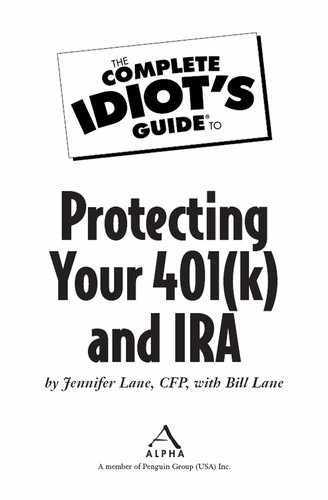Playing Catch-Up
While it’s great to start saving early, it’s never too late to start saving for retirement. If you’re starting late, you may have no hope of catching up, but you’ll be surprised at how fast the savings add up once you’ve got it on your radar screen.
First Step: Income and Expenses
Start by closely mapping out your current living expenses. If you don’t have an expense-tracking system or don’t like the one you’re using, set up an online account aggregator mentioned in Chapter 5, like www.Yodlee.com or www.Mint.com, to help you. The aggregator will give you a quick picture of your overall expenses and make it easier to see what expenses you should change to make room in your budget for retirement investing. Many people are surprised to see exactly where their money goes each month and quickly see places they can make changes. Remember, every little bit counts; adding 1 or 2 percent of your pay to a retirement or savings account adds up quickly.
Once you have a good read on your monthly expenses, go through the spending list and check off those things that will change in retirement, such as commuting expenses, dry cleaning or uniform costs, and lunches at work. Next, add things to your list that you think will increase. This could include hobby expenses, travel, and additional health-care costs. Be as realistic as you can; try to imagine yourself retired today. What would you be doing, and what would you be spending? Sometimes people are discouraged from saving because they feel the goal is set too high to reach. They don’t start because they’re discouraged about their chances of succeeding. Creating a detailed retirement budget will help set your nest egg target at a reasonable level.

Nest Eggs
A fee-only financial planner can be a great resource to help you calculate the nest egg you need and the amount you should be saving. Fee-only planners charge only for their advice. They don’t sell investment products for commission, and therefore have no conflict of interest in your investment choices.
Practice Retirement
A great way to find out if you can live on the income you’re targeting your nest egg savings toward is to start practicing now. No, this doesn’t mean you can quit your job and head for the beach! Practicing retirement means setting up your bank accounts so you can pay your work expenses from one and what will become your retirement expenses from another. Following the expense list you just created, assign one bank account to pay for the things that are exclusively work-related expenses and use the account you’ve assigned as your retirement bank account to cover everything else. Direct deposit your paycheck between the two accounts. With this system, you’ll see pretty quickly what living on a retirement income amount will feel like. Plus, because you’ll be closely watching your expenses, you may discover some places where you can shift money to savings.

Nest Eggs
Whether you have a partner or you’re single, monthly money meetings (M&Ms) are an important part of keeping your retirement nest egg intact and your savings on track. Schedule 30 minutes a month to review your income, expenses, goals, and investments, and make adjustments as needed (see Chapter 1).
Transition Job
Planning for a retirement job is another way to boost your retirement plan if you’ve started saving late. A retirement job can be a toned-down version of your current job or something completely different. If you like what you do and it’s something you can do part-time, great. If you’re ready for a change, this is your chance to think outside the career box.
If your job involves lots of brain space and thought even when you’re not at work, it might be fun to try something you won’t take home with you. Would you like to work more—or less—with the public? Would you like to work outdoors instead of indoors or inside instead of outside? The beauty of a retirement job is that, because it’s a supplemental income, you can worry less about trying something you may like only for a short time. You’ll be able to try something fresh, and not necessarily long term, more easily than you were able to when your job was your living.
Once you’ve thought about your retirement job, find out how much you might earn at the job in today’s market. Assume that the pay will increase in step with inflation and decide how many years you’ll work. Then apply that purposed extra income to your calculation. You’ll need less of a nest egg to retire if you’re working part-time.
..................Content has been hidden....................
You can't read the all page of ebook, please click here login for view all page.
